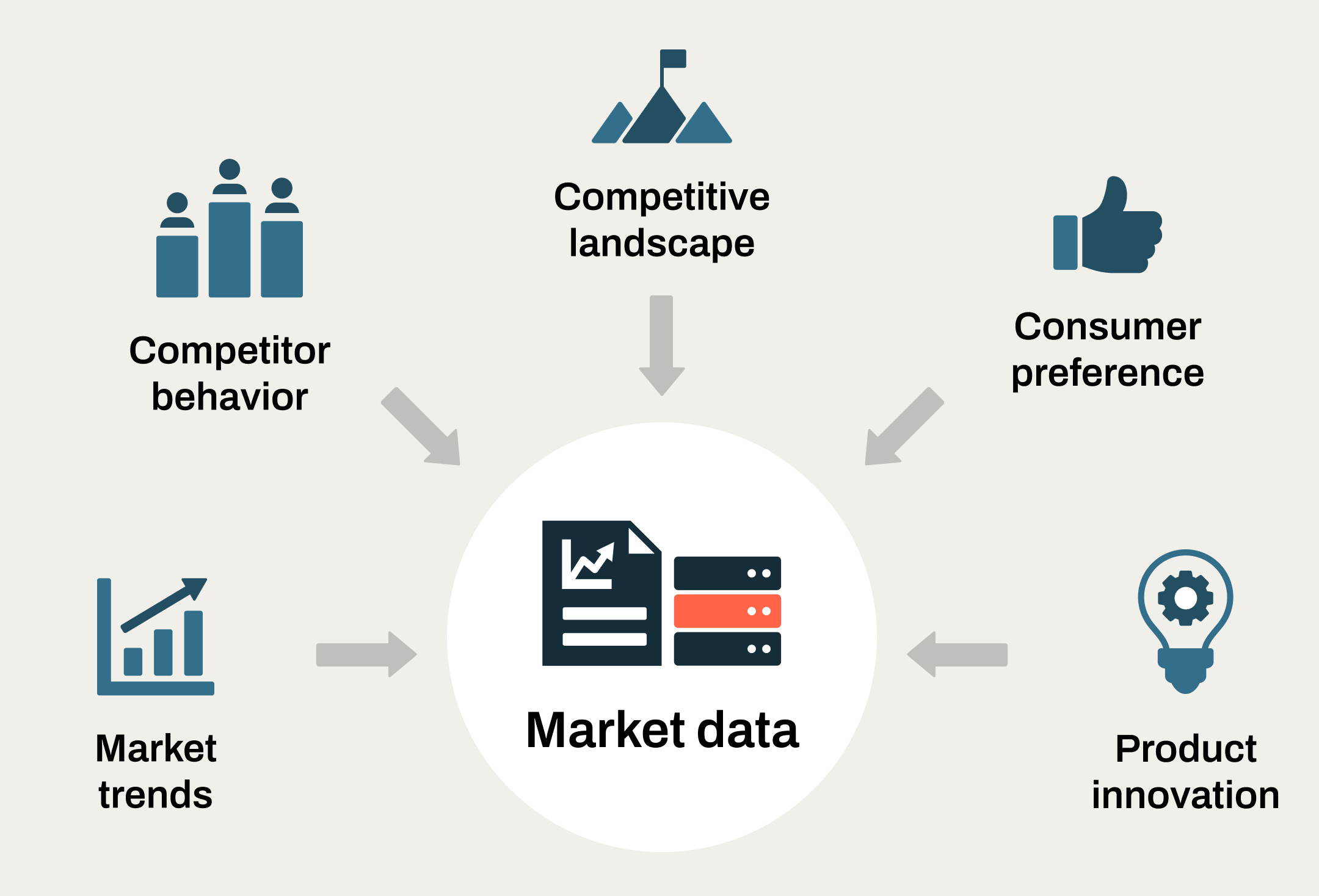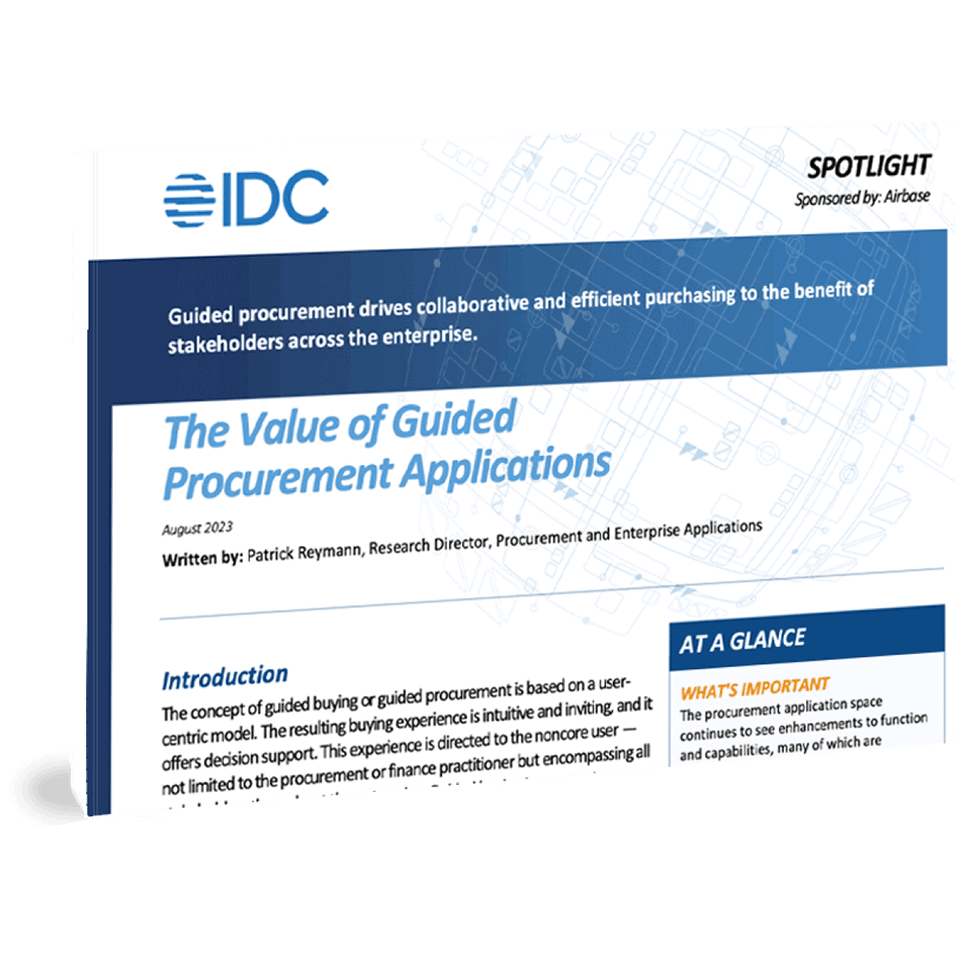Procurement market intelligence (PMI) is the process and practice of using market insights, analytics, data, and trends to inform procurement decisions. With informed procurement market intelligence, organizations can make data-driven decisions that help them adapt to an often mercurial business landscape.
What is procurement market intelligence?
Procurement market intelligence refers to both the systematic collection of data and the analysis of that data to discern trends, discover new suppliers, build awareness of product innovations, identify risks, and make forecasts. By harnessing this information, organizations can optimize strategic sourcing, identify savings, and align procurement practices with their overall business objectives.
Procurement market intelligence will be aligned to support the strategic objectives of the procurement operation. This means that market intelligence must be collected and analyzed for all aspects of procurement. This includes market factors that can impact the supply chain if physical goods are being purchased. It would also focus on market factors that can impact the cost of items or services purchased. More complex factors will go into the intelligence needed to support environmental, social, and corporate governance (ESG) policies.
For companies with a dedicated procurement team, procurement market intelligence is one function of that team.
In organizations without a procurement team, leveraging procurement market intelligence generally falls under the controller’s responsibility. In these situations, the reliance on the employee making the purchase for market intelligence is much greater. This reliance depends on enhanced visibility into the procurement process for informed decision-making and cost optimization across diverse departments and users. The more visibility teams have into vendors, the more optimized the procurement process will be.

Key components of procurement market intelligence.
Supplier intelligence.
Gathering information on suppliers is crucial for understanding both delivery performance and cost drivers. The process of collecting and analyzing supplier market data involves several key steps:
- Identify the important criteria and relevant metrics that support procurement goals, such as financial stability, delivery performance, quality standards, scalability, and regulatory compliance.
- Gather data through a variety of sources, including third-party databases, industry reports, customer interviews, and onsite audits.
- Organize and analyze supplier performance and capabilities, which could include looking at historical data and innovation potential.
This process helps with supplier selection, negotiation strategies, and maintaining supplier relationships.
Market and competitive intelligence.
Understanding the nature of the market and the competitive landscape helps anticipate change and the ability to adapt procurement strategies to meet those changes.
Knowing who alternative suppliers are can protect against risks such as poor performance, low quality, or price increases. Keeping tabs on the market and who the key competitors are can support negotiations with suppliers, reduce supply chain disruptions, and help organizations swiftly respond to market shifts.
Price intelligence.
Understanding pricing trends is crucial for making cost-effective procurement decisions. There are a few ways to approach this.
- Regular market analysis: Monitor the prices of goods and services in your supplier’s industry. This can be done through industry reports, market intelligence tools, and keeping abreast of economic indicators.
- Benchmarking: Compare procurement costs to industry benchmarks. Employing e-sourcing platforms and procurement analytics tools provide real-time data on supply market intelligence, including pricing and performance, allowing organizations to track variances and negotiate favorable terms.
- Good relationships with suppliers: Facilitate open communication about pricing and understanding that ensuring any fluctuations can be addressed proactively.
Compliance intelligence.
Procurement market intelligence plays a crucial role in ensuring suppliers and procurement practices comply with relevant laws and regulations. It helps organizations stay informed about regulatory landscapes by monitoring updates, legal requirements, and industry standards. Analyzing a supplier’s track record, certifications, and adherence to legal standards also helps reduce risk.
Software purchases rely on SOC reports to ensure compliance with security and privacy standards. Gathering and maintaining these reports is done during the purchasing and renewal process.
Airbase’s Guided Procurement workflows ensure all stakeholders have visibility into potential compliance risks. For example, the InfoSec team can review contracts in their business tools, such as Jira, at the procurement request intake to ensure critical SOC reports are received, reviewed, and retained.

Procurement market intelligence contributes to a company’s success in several ways.

The Value of Guided Procurement Applications
Learn more with IDC’s spotlight paper to find out how procurement is being transformed.
The benefits of implementing procurement market intelligence.
Procurement market intelligence can play an important role in business success. Here are some of the main benefits.
Competitive advantage.
By understanding the competitive landscape, companies can differentiate their products, tailor procurement strategies, and respond quickly to market changes.
By analyzing market dynamics and pricing trends, organizations can also negotiate favorable terms with suppliers, leading to cost efficiencies.
Cost savings.
Saving a company money is central to the procurement function. The better market intelligence the procurement team has, the more cost-effective it can be when making purchases — whether that is through competitor bids, alternative sources, or negotiating better terms by understanding the landscape better.
Supplier performance improvement.
Comprehensive insights into supplier capabilities, financial stability, and market trends help facilitate informed decision-making during supplier identification and selection. This intelligence-driven approach extends to negotiation and contracting, enabling organizations to conduct data-driven negotiations, optimize contract terms, and align agreements with market dynamics.
Supply chain optimization.
Procurement market intelligence facilitates supply chain optimization by providing real-time insights into market conditions, enabling proactive risk management and informed decision-making. Additionally, it supports demand forecasting and collaborative planning with suppliers, enhancing overall supply-chain efficiency and responsiveness.
Market trend analysis.
Organizations can gain a comprehensive understanding through market research that analyzes market conditions, supplier behaviors, and emerging industry trends. This information is crucial during a company’s planning process.
Improve supplier/vendor discovery.
Widening the scope of procurement market intelligence can reveal new vendors and suppliers. It can also bring new innovations to light that can contribute to a company’s success.
Take a tour of Guided Procurement.
Click through this interactive tour of Airbase’s Procurement capabilities.
Implementation of procurement market intelligence.
Implementing procurement market intelligence within an organization involves a strategic and systematic approach. Here is a step-by-step guide.


Identify and collect relevant data sources.
Define key performance indicators (KPIs): Clearly define the KPIs that align with your procurement objectives. These could include metrics such as spend under management, cost savings, supplier performance, and market share
Assess current capabilities: Evaluate the organization’s current data infrastructure, technology, and analytical capabilities. Identify any gaps that need to be addressed to support market intelligence initiatives effectively.
Select relevant data sources: Identify and select the most relevant data sources. This may include industry reports, supplier databases, economic indicators, and internal data.
Invest in technology: Implement or upgrade technology solutions for data collection, analysis, and reporting. This may involve adopting procurement analytics tools, market intelligence solutions, or custom solutions based on organizational needs
Stay informed about industry trends: Monitor and participate in relevant forums.
Prioritize data quality: Validate accuracy and reliability, ensuring compliance with legal and regulatory requirements.
Analyze and interpret the data.
Analyzing market intelligence data and interpreting it for actionable insights involves a structured approach to extract meaningful information. Here’s a guide on how to carry out this process.
Data cleaning and pre-processing: Start by cleaning and pre-processing the data to ensure accuracy and consistency. Address any missing or erroneous data points, standardize formats, and eliminate duplicates.
Segmentation and categorization: Segment the data into relevant categories, such as suppliers, products, or geographic regions. This segmentation enables a more granular analysis, allowing for targeted insights.
Conduct comparative analysis: Compare different data sets to identify correlations and trends. This could involve comparing supplier performance over time, analyzing regional variations, or benchmarking against industry standards.
Employ predictive analytics: Use predictive analytics to forecast future trends based on historical data. This can help anticipate market changes, demand fluctuations, and potential risks.
Risk analysis and mitigation: Perform risk analysis by identifying potential threats to supply markets or procurement processes. Develop mitigation strategies based on the insights gained to enhance resilience.
Cost-benefit analysis: Conduct cost-benefit analyses to evaluate the impact of different procurement strategies. Real-time spending data can help assess the trade offs between cost, quality, and supplier performance to inform decision-making.
Cross-functional collaboration: Collaborate with cross-functional teams, including finance, operations, and marketing, to gain a holistic perspective. Integrating insights from various departments enhances the overall strategic impact.
Develop intelligence reports.
Organize the report with a clear structure, including an executive summary, methodology, key findings, and actionable insights. Use visuals such as charts and graphs to enhance data comprehension.
Provide insights into historical trends and benchmark procurement data against industry standards or past performance. This contextual information helps stakeholders understand the evolution of key metrics and puts current market trends into context.
Translate those insights into actionable recommendations. Clearly articulate suggested actions and strategies that align with the business operation’s overarching goals.
By following these steps, organizations can compile market intelligence data into comprehensive reports that serve as valuable tools for strategic decision-making in procurement, ultimately contributing to improved efficiency and competitiveness.
Implement the findings into your procurement processes.
Organizations should establish clear communication channels between the analytics team and procurement professionals to integrate insights from procurement market intelligence reports into practical procurement processes.
- Develop streamlined processes for sharing and discussing intelligence findings, ensuring that the information is easily accessible and comprehensible.
- Encourage cross-functional collaboration, fostering a culture where data-driven insights are seamlessly integrated into decision-making processes. Implement training programs to enhance the data literacy of procurement teams, enabling them to leverage intelligence effectively.
- Regularly revisit and update eprocurement strategies based on the latest insights, ensuring a dynamic and responsive approach to market dynamics and trends.
Streamlining procurement with Airbase.
When automated processes take over the procurement process from initial intake to GL booking, you can focus more time on strategic initiatives like procurement market intelligence. The right procurement management software frees up that time without giving up control or compliance.
Find out how Airbase helps — schedule a demo with us!
Schedule a demo
Learn how Airbase can transform your entire purchasing process.
 Jira Integration – Streamline Your Workflows
Jira Integration – Streamline Your Workflows  Ironclad Integration – Simplify Legal Operations
Ironclad Integration – Simplify Legal Operations  Asana
Asana 




